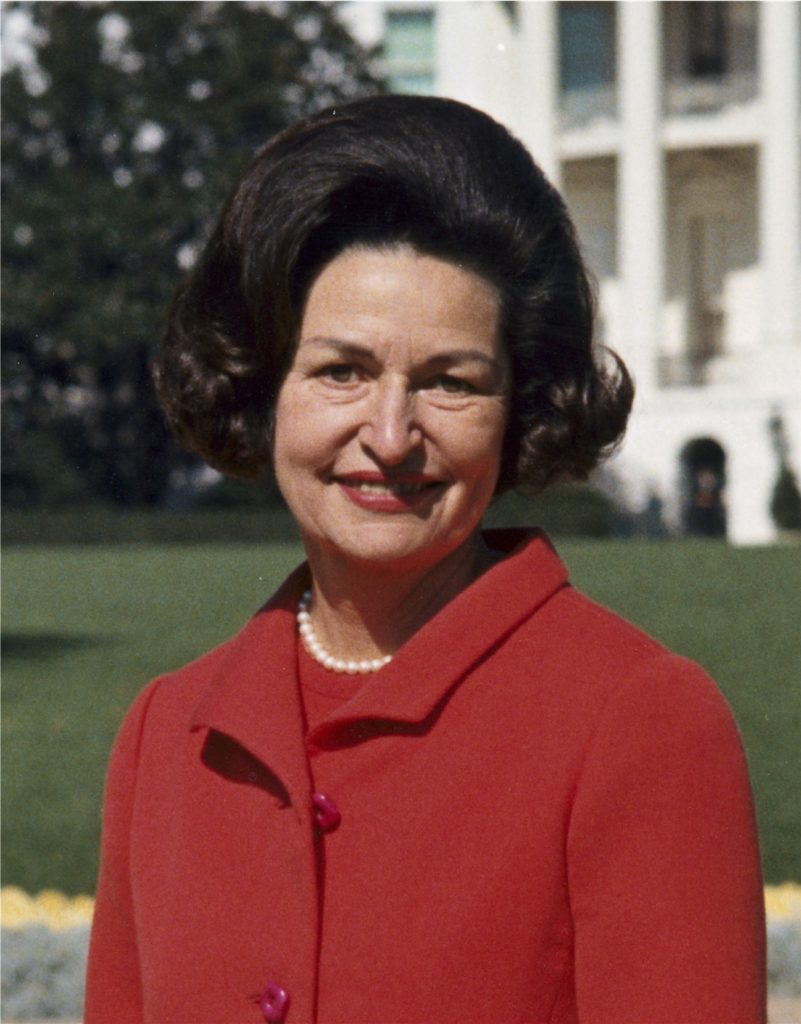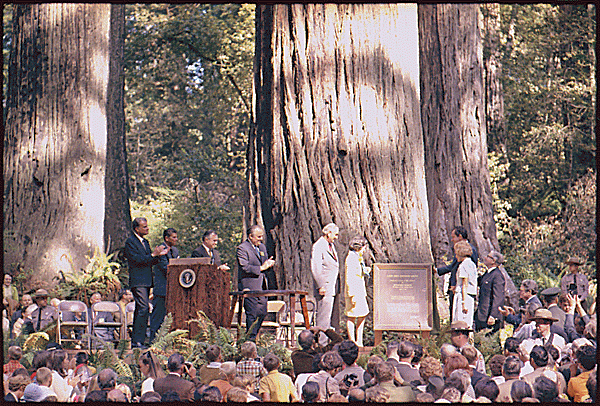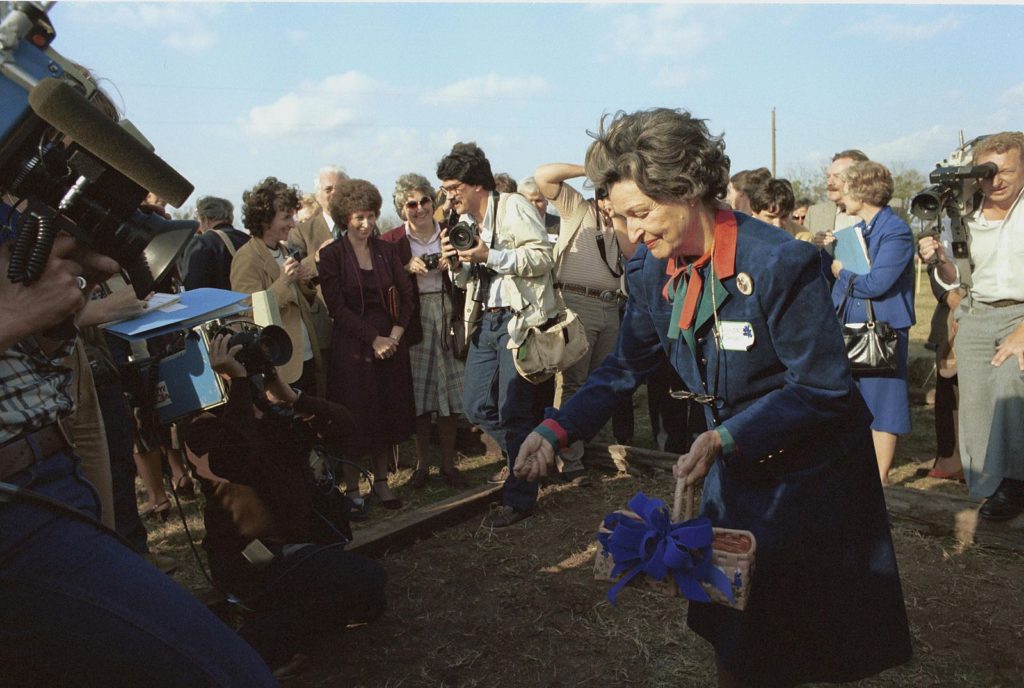History credits Teddy Roosevelt, Franklin Roosevelt and, perhaps, Richard Nixon as America’s great conservation presidents. But what about the other predominant member of a president’s team—his wife. Without question, the most important conservation presidential wife was Lady Bird Johnson. Known as the country’s “environmental first lady,” Mrs. Johnson (as her organization’s website refers to her) was the impetus for much of the modern environmental movement.

Claudia Alta Taylor was born in Karnack, Texas, on December 22, 1912 (died 2007). A friend said she was “as purty as a lady bird,” and she was known from then on as Lady Bird. She grew up roaming the woods, fields and waters of eastern Texas. “My heart found its home long ago,” she wrote, “in the beauty, mystery, order and disorder of the flowering earth.”
She earned a journalism degree from the University of Austin, Texas. Soon after, she met a young politician, Lyndon Baines Johnson (LBJ, as we know him), and soon became Lady Bird Johnson. She bought a failing radio station in Austin and built it—doing everything from planning the programming to cleaning the floors—into a thriving broadcasting enterprise that included radio and television stations and a cable television system. As the wife of an influential Texas congressman and senator and then vice-president, she became a part of the Washington, DC establishment.
Her life changed on November 22, 1963, when President Kennedy’s assassination vaulted her husband into the presidency and her into the role of first lady. She decided that she would be a “doer” as first lady, and the things she sought to do mostly involved the environment. Her work took on the moniker of “beautification,” but her idea was not just to make the world pretty. She said, “Though the word beautification makes the concept sound merely cosmetic, it involves much more: clean water, clean air, clean roadsides, safe waste disposal and preservation of valued old landmarks as well as great parks and wilderness areas. To me…beautification means our total concern for the physical and human quality we pass on to our children and the future.”

She worked closely with the president to move environmental matters to the top of the political and societal agenda. Together, they pushed for—and accomplished—legislation that protected the landscape of federal interstate highways (the 1965 Highway Beautification Act is commonly known as “Lady Bird’s Bill”), created scores of national park units, provided permanent funding for protecting high priority conservation sites, and rejuvenated the city of Washington, DC. Lady Bird’s Bill is why interstate highways have wide rights-of-way and are not littered with billboards, junkyards and other scars of the industrial age. At the end of his presidency, LBJ gave his wife a large plaque which held 50 pens he had used to sign 50 environmental measures into law. The plaque read, “To Lady Bird, who has inspired me and millions of Americans to try to preserve our land and beautify our nation. With love from Lyndon.”

She found many ways to inspire others. She led excursions to many national parks, usually with politicians and national media in tow, to demonstrate the importance of natural places to the nation’s physical and mental health. Back in Texas, she led the drive to build a 10-mile trail around a lake in Austin—the lake is now named for her. On her 70th birthday, she founded what is now called the Lady Bird Johnson Wildflower Center. Just outside Austin, the center covers 279 acres and displays more than 650 native plant species.
Speaking to an audience of architects in 1968, Johnson summarized her philosophy.: “Too often we have sacrificed human values to commercial values under the bright guise of progress. And in our unconcern, we have let a crisis gather which threatens health and even life itself … Today, environmental questions are matters for architects and laymans alike. They are questions, literally, of life and death. Can we have a building boom and beauty too? Must progress inevitably mean a shabbier environment? Must success spoil nature’s bounty? Insistently and with growing volume, citizens demand that we turn our building to a sensible, human purpose. They are asking, literally, for a breath of fresh air.”
When you breath that fresh air, one of the folks you should thank is Lady Bird Johnson, our Environmental First Lady.
References:
Benepe, Adrian. 2015. How the White House Went Green: The Environmental Legacy of President Lyndon B. Johnson and Lady Bird Johnson. The nature of cities, 1 November 2015. Available at: https://www.thenatureofcities.com/2015/11/01/how-the-white-house-went-green-the-environmental-legacy-of-president-lyndon-b-johnson-and-lady-bird-johnson/. Accessed December 12, 2019.
Gould, Lewis L. 2012. The environ;mental legacy of Lady Bird Johnson. Houston Chronicale, August 3, 2012. Available at: https://www.chron.com/opinion/outlook/article/The-environmental-legacy-of-Lady-Bird-Johnson-3761366.php. Accessed December 12, 2019.
Lady Bird Johnson Wildflower Center. The Environmental First Lady. Available at: http://www.ladybirdjohnson.org/biography. Accessed December 12, 2019.

